Shame about Shain! Early Australian radio astronomy at Hornsby Valley
Introduction
Between 1946 and the early 1960s, pioneering scientists based at a number of different field stations near Sydney were responsible for building Australia's reputation as a world leader in the new field of radio astronomy (see Orchiston and Slee, 2005). One of these was Alex Shain. Charles Alexander Shain was born in Melbourne on 6 February 1922, and after completing a B.Sc. degree at the University of Melbourne and serving briefly in the military, he joined the CSIR's Division of Radiophysics in November 1943. During the war he worked on the Division's radar program and in the immediate post-war years championed "low frequency" radio astronomy in Australia, first at Hornsby Valley field station and later at Fleurs. When Shain died on 11 February 1960, Australia lost one of its pioneers, and its leading authority on decametric radio emission. Pawsey (1960:245) described Shain as " a wonderful colleague in the laboratory, imaginative, well balanced, exceedingly unselfish, and a real friend to all". In this article we review his work at Hornsby Valley.
Hornsby Valley field station
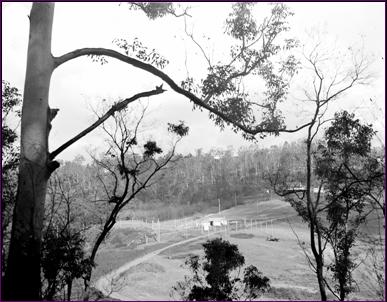 Figure 1: Panoramic view of the Hornsby Valley field station in 1952, showing antennas and an instrument hut.
Figure 1: Panoramic view of the Hornsby Valley field station in 1952, showing antennas and an instrument hut. The picturesque Hornsby Valley field station (Figure 1) was located on farmland in a quiet valley to the west of the Pacific Highway, and between 1947 and 1952 was home to a number of unusual radio telescopes. Under the auspices of Frank Kerr, Ruby Payne-Scott, Alex Shain and Charlie Higgins these were used to carry out pioneering studies in lunar, solar and galactic astronomy.
The first research conducted at this field station was in radar astronomy: in 1947 – 1948 Kerr and Shain spent a year bouncing signals off the Moon in order to investigate the structure of the upper ionosphere. A rhombic aerial linked to a modified communications receiver recorded the bounced signals (Figure 2), which were broadcast at 17.84 and 21.54 MHz by Radio Australia from Shepparton in Victoria.
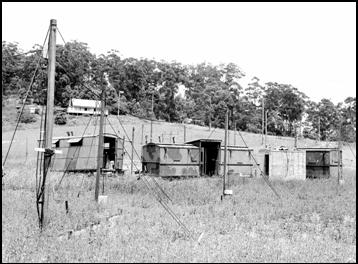 Figure 2: The antennas and instrument huts used for the Moon-bounce project.
Figure 2: The antennas and instrument huts used for the Moon-bounce project.
Thirty different experiments were carried out, and echoes were received on twenty-four occasions; as expected, these provided further information about the Earth's ionosphere, but from an astronomical viewpoint the interesting conclusion that Kerr and Shain drew was that the nature of the echoes showed the Moon's surface to be "rough" rather than smooth (Kerr & Shain, 1951). Kerr then transferred to Potts Hill (where he went on to make a name for himself through his H-line work).
Payne-Scott moved to the Hornsby Valley towards the end of 1947 with the intention of expanding the solar work she had begun at Dover Heights. She set up 60, 65 and 85-MHz Yagis, and from January through to September 1948 used these, the Kerr-Shain Moon-bounce rhombic antenna and an 18.3-MHz broadside array to study solar bursts before she also transferred to Potts Hill field station.
With Payne-Scott and Kerr gone, Shain and Higgins were able to develop Hornsby Valley into the Radiophysics Division's forefront "low frequency" field station. In 1949, they erected an array of eight half-wave dipoles strung between four rows of telegraph poles with the ground serving as a reflector, and used this novel radio telescope to investigate galactic emission at 18.3 MHz (Shain, 1951). The antenna system was attached to a standard communications receiver, and observations were carried out between May and November 1949. The success of these early observations led Shain and Higgins to expand the array to 30 horizontal half-wave dipoles, so that a more detailed survey could be carried out with a smaller beam. Although the antenna was stationary it was possible to move the beam electronically, and this meant that a wide strip of sky from declination -12° to -50° could be surveyed (Figure 3).
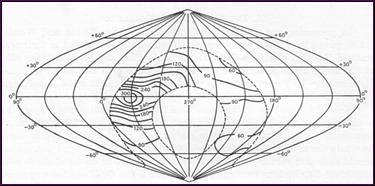 Figure 3: Galactic co-ordinate plot of continuum emission at 18.3 MHz (after Shain 1954: 152).
Figure 3: Galactic co-ordinate plot of continuum emission at 18.3 MHz (after Shain 1954: 152).
The observations were carried out between June 1950 and June 1951, and only about 10% of all records were unusable through interference or atmospherics (Shain, 1954).
In June 1951 the 18.3-MHz radio telescope was replaced by a network of 12 fixed horizontal half-wave dipoles, operating at 9.15 MHz. This utilised some of the original telegraph poles, in four parallel banks each of three dipoles. The array was attached to a standard communications receiver. Like its predecessor, this was a transit instrument which relied on the Earth's rotation in order to record radio emission from different strips of the sky (but this time without directing the beam). Once again, Sydney's fortuitous latitude meant that the celestial region of greatest interest, the Galactic plane and centre of the Galaxy, would pass almost directly overhead. Between July 1951 and September 1952 this radio telescope was used by Shain and Higgins to scan a strip of sky centred on declination -32° (Higgins and Shain, 1954). It was in August 1952, during this research project, that some of the delegates from the URSI Congress which was meeting in Sydney visited Hornsby Valley and were given a guided tour of the site (see Figure 4).
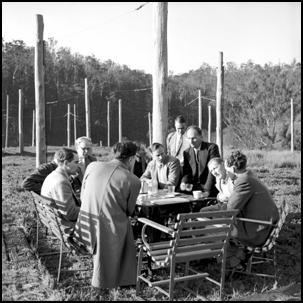 Figure 4: Radio astronomers from the 1952 URSI Congress at Hornsby Valley. Shain is on the extreme left, seated between Hanbury-Brown and Graham Smith while Higgins, in the dark jacket, is sitting opposite him.
Figure 4: Radio astronomers from the 1952 URSI Congress at Hornsby Valley. Shain is on the extreme left, seated between Hanbury-Brown and Graham Smith while Higgins, in the dark jacket, is sitting opposite him.
After completing the 9.15-MHz survey, Shain planned to embark on a major new decametric project, but he concluded that "The Hornsby station will not be satisfactory [due to] lack of adequate open level space Hence we should plan to progressively evacuate Hornsby — breaking down the gear now in use after October 1952." (Shain, 1952). While Shain suggested Badgery's Creek as a suitable site for the new "low frequency" work, it was in fact Fleurs that benefited from the eventual close-down of the Hornsby Valley field station in 1955, acquiring the distinctive 19.7-MHz Shain Cross (see Orchiston and Slee, 2002). This was completed in 1956, but Shain was only able to enjoy this new facility for four short years before cancer brought a premature end to his life.
The "Lost Opportunity"
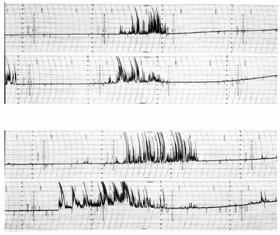 Figure 5: Examples of 18.3-MHz Jovian bursts noted on the 1950 – 1951 Hornsby Valley chart records.
Figure 5: Examples of 18.3-MHz Jovian bursts noted on the 1950 – 1951 Hornsby Valley chart records. There is one fascinating post-script to this story. A common Hornsby Valley problem at 9.15 and 18.3 MHz was terrestrial interferencewhich Shain and Higgins tended to dismiss as rather a nuisancebut when Burke and Franklin reported the discovery of decametric burst emission from Jupiter in 1955 they were forced into a rethink. When he revisited some of those periods of "intense static" recorded at 18.3 MHz in 1950 and 1951 (see Figure 5), Shain found that these were indeed Jovian bursts, and this serendipitous "pre-discovery" proved to be one of RP's most notable "lost opportunities". Shain (1956) noticed that the bursts were not uniformly distributed in Jovian longitude but tended to cluster between 0° and 135°. In other words, much of the radiation appeared to derive from a localized region on the planet, and its rotation period was 9h 55m 13±5s, marginally longer than Jupiter's System I rotation period. Only later would we come to associate Jovian decametric emission with the magnetic torus linking Jupiter and its enigmatic inner moon, Io.
References
Higgins, C.S., Shain, C.A. 1954, Austr.J.Phys., 7, 460
Kerr, F.J, Shain, C.A. 1951, Proc.I.R.E., 39, 230
Orchiston, W., Slee, B. 2002, ATNF News, 47, 12
Orchiston, W., Slee, 2005, The Radiophysics field stations and the early development of radio astronomy. In Orchiston, W. (ed.), The New Astronomy: Opening the Electromagnetic Window and Expanding our View of Planet Earth, New York, Springer, in press.
Pawsey, J.L. 1960, QJRAS, 1, 244
Shain, C.A. 1951, Austr.J.Sci.Res., A4, 258
Shain, C.A. 1952, Memorandum to Joe Pawsey, 6 February in RP Archives: A1/3/1(a)
Shain, C.A. 1954, Austr.J.Phys., 7, 150
Shain, C.A. 1956, Austr.J.Phys., 9, 61
Wayne Orchiston, AAO & ATNF and Bruce Slee, ATNF
(Wayne.Orchiston@csiro.au, Bruce.Slee@csiro.au)
